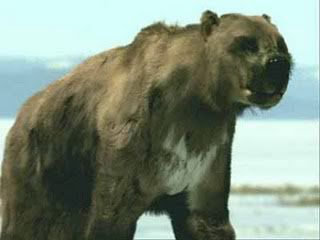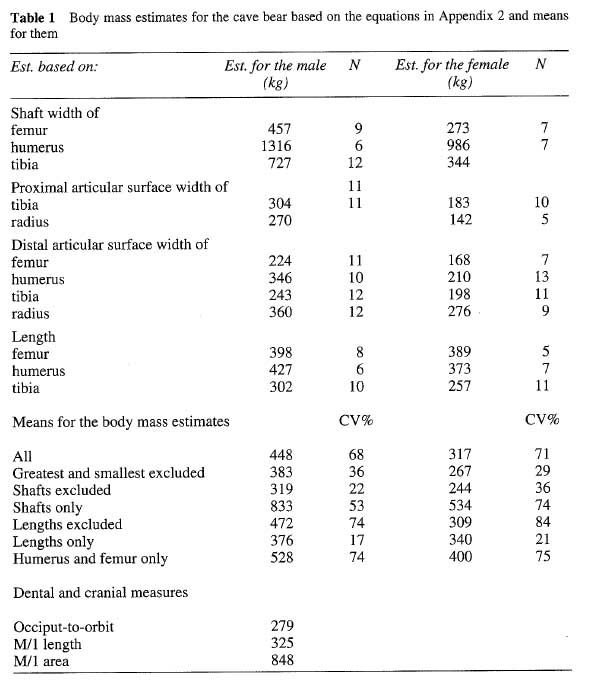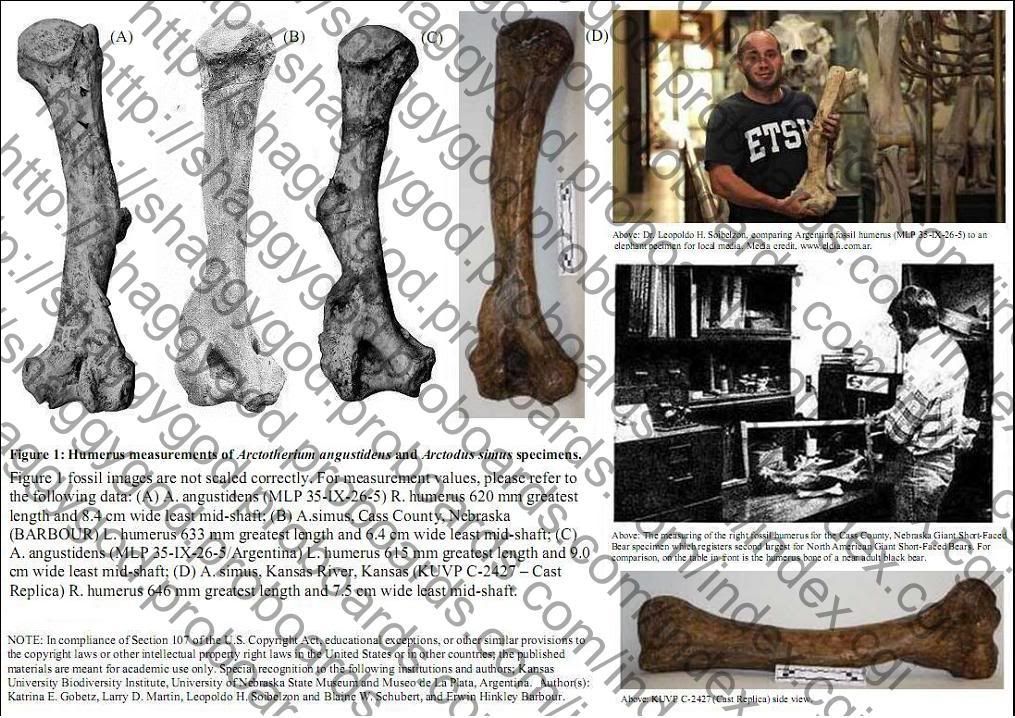Post by grrraaahhh on Oct 9, 2011 19:19:04 GMT -9
continued....


The earlier humerus data make up the top four (three bears total) GSFB largest humerus fossils. Two bears are from North America, the other & heaviest bear is from Argentina.
KUVP 131586: Regrettably, the distal end for this left femur is missing so the incomplete data was ignored.
UC 44686 (1st in total length of GSFB ulna fossils):
Ulna measurements
A: 591
B: -
C: 65
D: 47
E: 35.2
A. Greatest Length.
B. Proximal diameter from tip of coronoid progress to Margo dorsalis.
C. Smallest diameter from bottom of semi circular notch to Margo dorsalis..
D. Inner diameter of semi circular notch.
E. Least transverse diameter of shaft, above capitulum.
UC 44687 (2nd total length GSFB femur)
Femur Measurements:
A. 678
B. a165
C. 77
D. 62
E1. 134
A. Greatest Length.
B. Greatest proximal width.
C.Caput diameter.
D. Least transverse width of shaft.
E1. Greatest distal width over epicondyles.
Source: Kurten (1967).
Both CA specimen unpublished photos have been obtained & plans are to publish them later similar to the earlier humerus figure material. Ideally, I was hoping to obtain photos for the Hay Springs bear for a comprehensive publication but travel issues & scheduling conflict have complicated matters.
Femoral measurements (1st in total length GSFB femur fossil):
UVP 015 Lake Bonville, Utah Specimen & Material:
UVP 015/1
Greatest length: 723
Greatest proximal width: 191
Caput diameter: -
Least transverse width of shaft: 64
Greatest distal width over condyles: 152
shaggygod.proboards.com/index.cgi?board=americaspleistocene&action=display&thread=329&page=2
See reply # 22.
Keep in mind, different fossil models produce different weight estimates. There are some data I want to review. I will try to follow up more shortly.
Body Mass Estimation
More to come.....


But i'm not sure because there were probably enormous cave bears specimens...
I moved your post, profiles are meant to be locked for staff access only (my mistake).
Conventional cave bear body mass estimates produce weight estimates lower than 850 kg however.....
The cave bear appears to have been rather similar in size to the polar bear and the large species of the brown bear, and it, thus, appears likely that the mass of exceptionally large males may have well exceeded 700 kg.
Christiansen, P. What size were Arctodus simus and Ursus spelaeus (Carnivora: Ursidae)? Annales Zoologici Fennici [Ann. Zool. Fenn.]. Vol. 36, no. 2, pp. 93-102. 1999. (1999).
FWIW, Christiansen does not support Vereshagin & Baryshnikov (1984) 1000 kg + body mass estimates for large male cave bears.
Another equation Viranta (1994) measuring humeral shaft width produced a high body mass estimate of 1316 kg for male cave bears.
Giant Short-Faced Bear & Cave Bear body mass estimates are popular/fun topics of discussion. It's easier to combine both of these topics into a single thread. So far, what's been covered materially speaking has been limited, there's quite a bit more to examine, stay tuned.....


The earlier humerus data make up the top four (three bears total) GSFB largest humerus fossils. Two bears are from North America, the other & heaviest bear is from Argentina.
KUVP 131586: Regrettably, the distal end for this left femur is missing so the incomplete data was ignored.
UC 44686 (1st in total length of GSFB ulna fossils):
Ulna measurements
A: 591
B: -
C: 65
D: 47
E: 35.2
A. Greatest Length.
B. Proximal diameter from tip of coronoid progress to Margo dorsalis.
C. Smallest diameter from bottom of semi circular notch to Margo dorsalis..
D. Inner diameter of semi circular notch.
E. Least transverse diameter of shaft, above capitulum.
UC 44687 (2nd total length GSFB femur)
Femur Measurements:
A. 678
B. a165
C. 77
D. 62
E1. 134
A. Greatest Length.
B. Greatest proximal width.
C.Caput diameter.
D. Least transverse width of shaft.
E1. Greatest distal width over epicondyles.
Source: Kurten (1967).
Both CA specimen unpublished photos have been obtained & plans are to publish them later similar to the earlier humerus figure material. Ideally, I was hoping to obtain photos for the Hay Springs bear for a comprehensive publication but travel issues & scheduling conflict have complicated matters.
Femoral measurements (1st in total length GSFB femur fossil):
UVP 015 Lake Bonville, Utah Specimen & Material:
UVP 015/1
Greatest length: 723
Greatest proximal width: 191
Caput diameter: -
Least transverse width of shaft: 64
Greatest distal width over condyles: 152
shaggygod.proboards.com/index.cgi?board=americaspleistocene&action=display&thread=329&page=2
See reply # 22.
Keep in mind, different fossil models produce different weight estimates. There are some data I want to review. I will try to follow up more shortly.
Body Mass Estimation
- There have been few attempts to estimate the size of the ‘short-faced’ bear. Where estimates were made, often the sample size was small.
- Limb bones are responsible for supporting the animal’s weight during locomotion (Anyonge, 1993; Christiansen and Harris, 2005), thus providing the best mass estimates for extinct species. Kurt´en (1967) used the reconstructed body length and the cross-sectional area of a femoral diaphysis of a large specimen from Hay Springs for calculating its mass as between 470 and 630 kg.
- Employing Kurt'en's method, Nelson and Madsen (1983) obtained an estimate of 620–660 kg for the specimen UVP 015 from Salt Lake County (Northern Utah), based on the diaphyseal area of the femur.
- Christiansen (1999b) used several measurements taken in the proximal limb bones to estimate the mean mass of three specimens of A. simus as ca. 770 kg.
Figueirido et al. (2010) measured the maximum length and least width of the diaphyseal shaft of each major limb bone in a data set of 58 specimens of the eight species of extant ursids. Log-transformed data were used for calculating least squares bivariate regression functions of body mass on each measurement. For each bear species, we used published estimates of average mass (Van Valkenburgh, 1990; Christiansen, 1999b, 2002; Egi, 2001; Anderson, 2004). The accuracy of the bivariate regression functions was evaluated from their percent prediction errors (%PE) and the percent standard error of the estimates (%SEE) following Smith (1981, 1984). Approximately one third of specimen body mass estimates approached one tonne - the author further speculates that bears of this size were more common than previously suspected. - Soibelzon and Schubert (2011) obtained body mass of South American short-faced bears following the estimates by Soibelzon and Tartarini (2009) employing the allometric equations published by other authors (e.g., Van Valkenburgh,1990; Anyonge, 1993; Viranta, 1994; Christiansen, 1999; Egi, 2001). The study by Soibelzon and Tartarini (2009) compared more than sixty equations based on teeth, skull and postcranial measurements, and found the most reliable predictor of body size for large specimens was six measurements of the humerus (proposed by Anyonge, 1993; Egi, 2001; Christiansen, 1999) and one on the radius (formulated by Viranta, 1994) (for more details see Soibelzon and Tartarini, 2009). Thus, the size of the individual described here is estimated based on the preserved humerus and radius using these seven equations. The result, the Argentine specimen had an estimated body mass ranging from 983 to 2,042 kg depending on the equations considered while the mean and median body mass estimates (considering all equations) were 1,588 and 1,749 kg respectively.
More to come.....

Oct 6, 2011 6:55:18 GMT -9 @tremarctinae said:
According to what i have ridden, Indarctos Atticus would be larger than ursus speleaus, with a body mass greater than 850kg...But i'm not sure because there were probably enormous cave bears specimens...
I moved your post, profiles are meant to be locked for staff access only (my mistake).
Conventional cave bear body mass estimates produce weight estimates lower than 850 kg however.....
The cave bear appears to have been rather similar in size to the polar bear and the large species of the brown bear, and it, thus, appears likely that the mass of exceptionally large males may have well exceeded 700 kg.
Christiansen, P. What size were Arctodus simus and Ursus spelaeus (Carnivora: Ursidae)? Annales Zoologici Fennici [Ann. Zool. Fenn.]. Vol. 36, no. 2, pp. 93-102. 1999. (1999).
FWIW, Christiansen does not support Vereshagin & Baryshnikov (1984) 1000 kg + body mass estimates for large male cave bears.
Another equation Viranta (1994) measuring humeral shaft width produced a high body mass estimate of 1316 kg for male cave bears.
Giant Short-Faced Bear & Cave Bear body mass estimates are popular/fun topics of discussion. It's easier to combine both of these topics into a single thread. So far, what's been covered materially speaking has been limited, there's quite a bit more to examine, stay tuned.....





